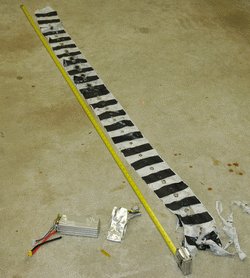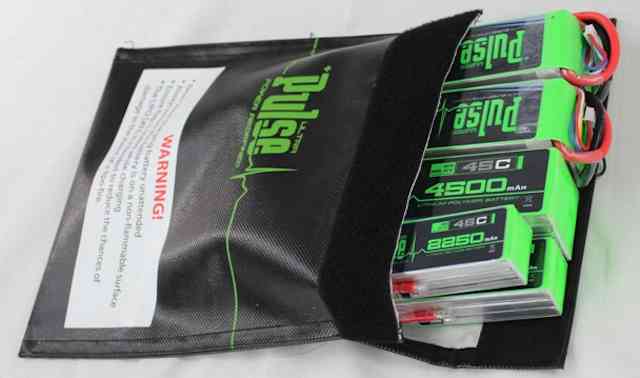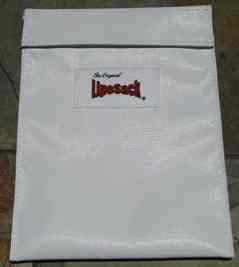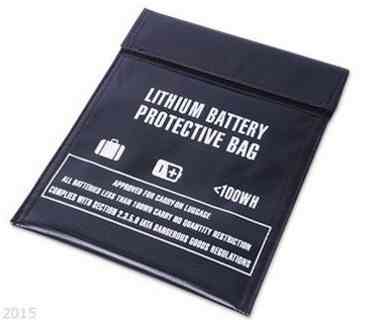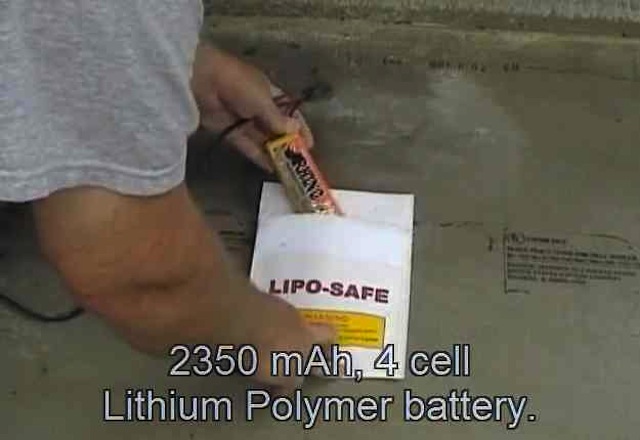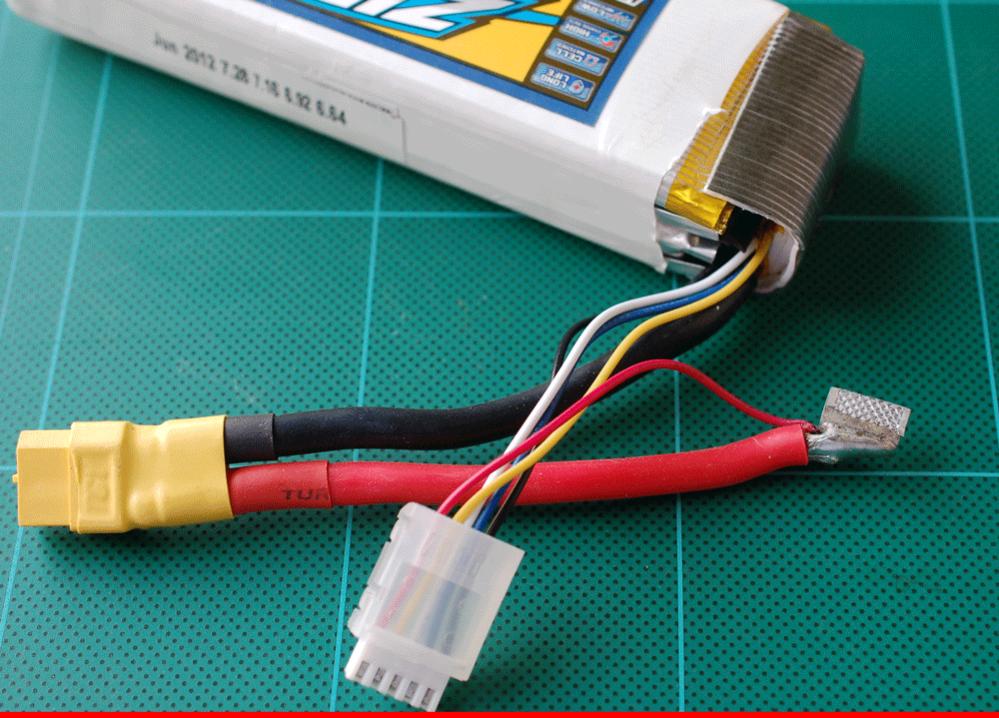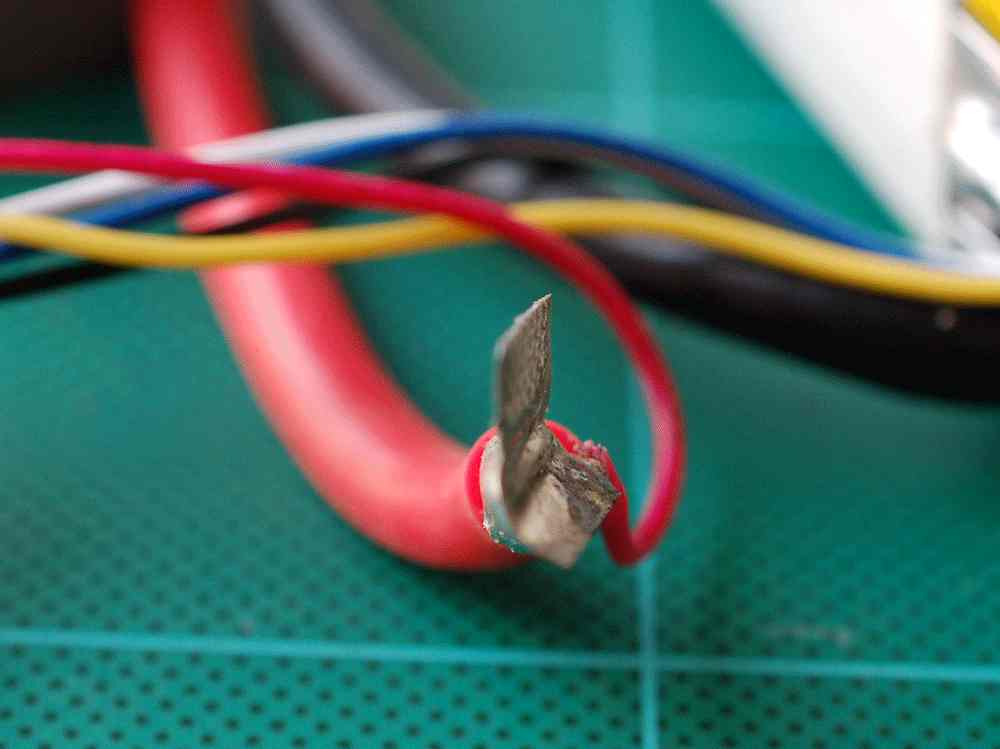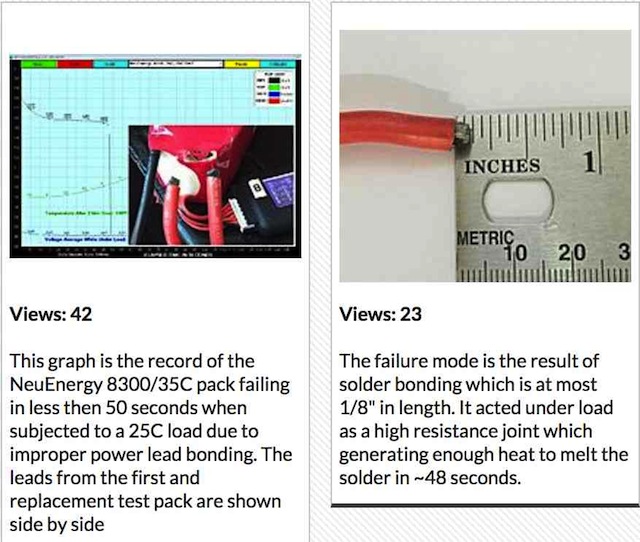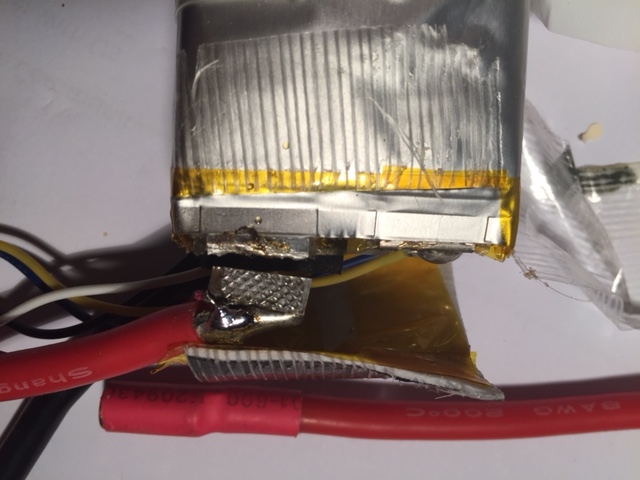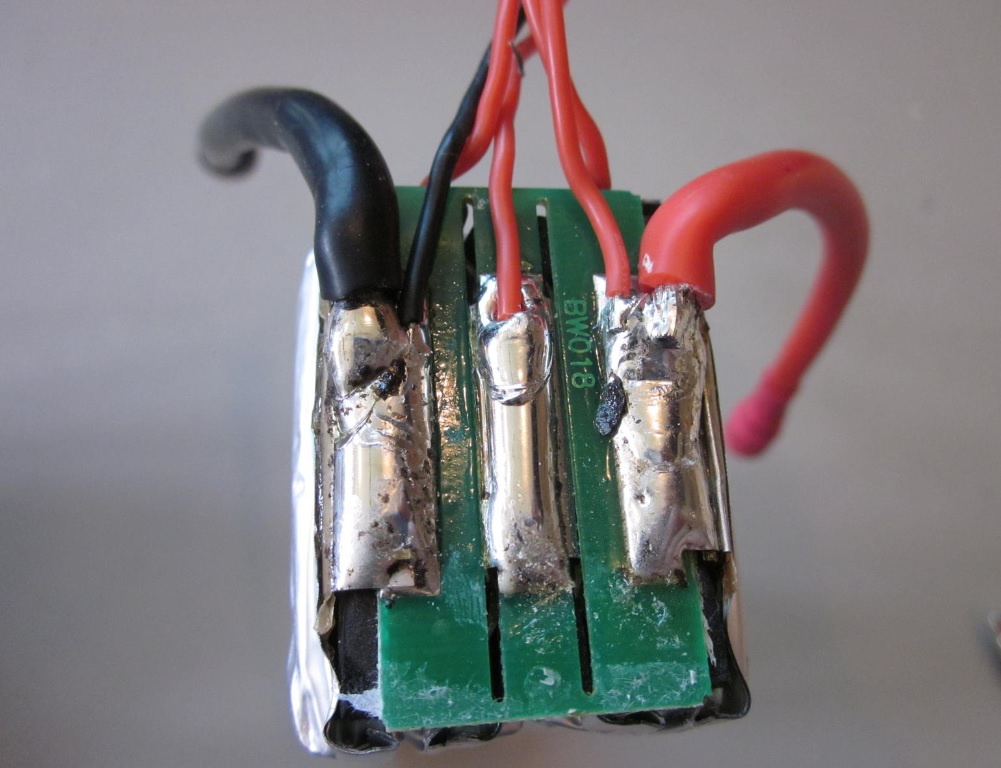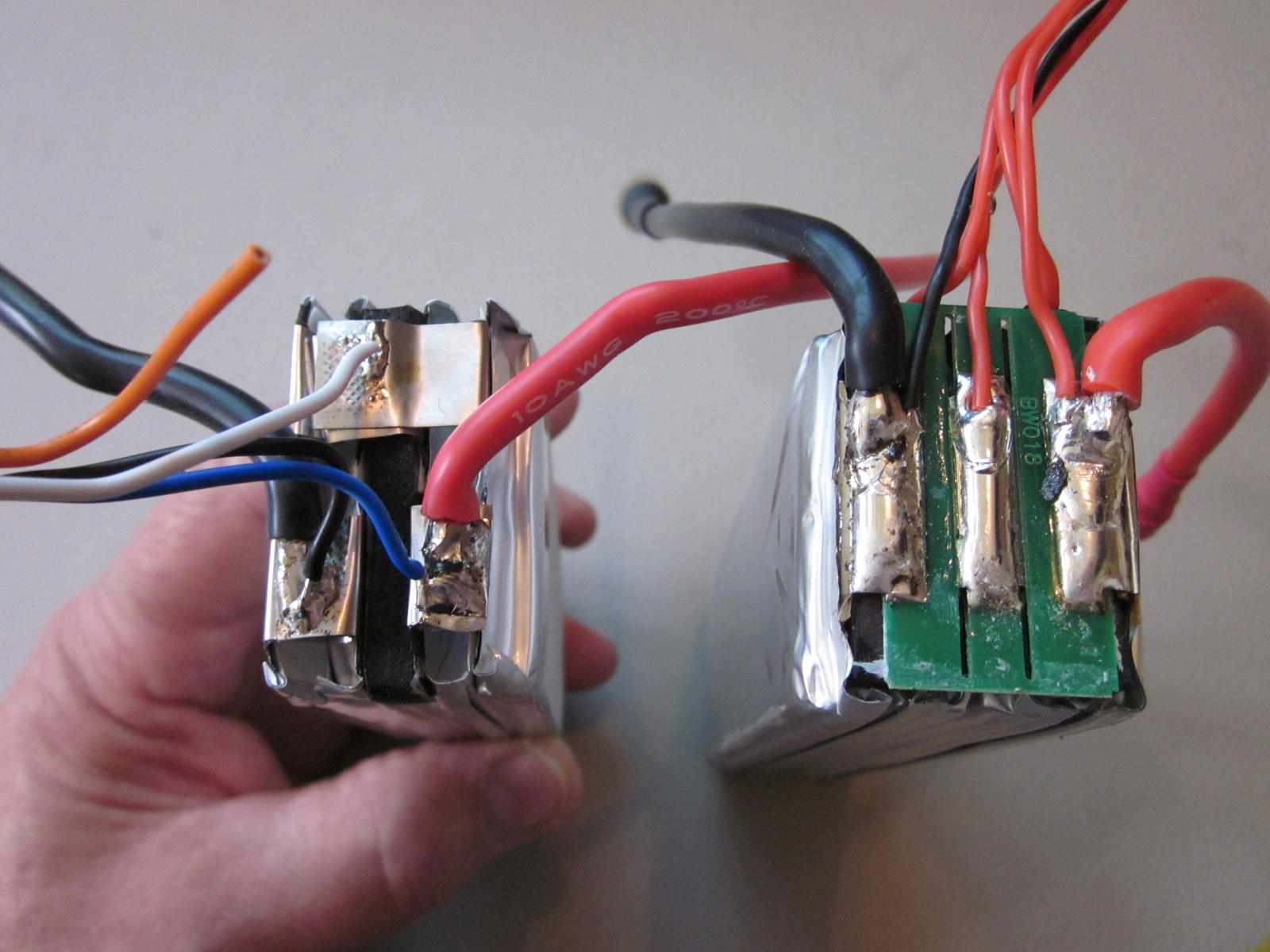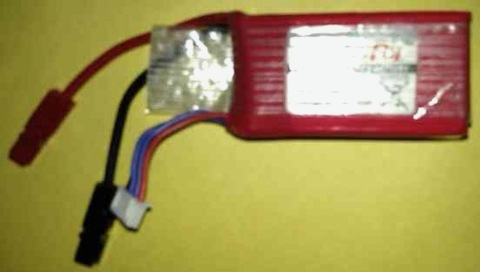Learning About LiPo Batteries
Edited, updated, link checked - November 2016
How Lithium Batteries Work Chemistry 101 Videos
Lithium-ion batteries: How do they work?
Web Sites
The Chemistry of LiPO
Videos
Grepow factory tour
Gens ace lipo battery production process-Powered by GensAce 2:46
Tour of unknown factory that makes cells for Revolectrix 13.01
John Grazan explains how LiPo batteries are made. 6.50
L&E Giant Power Dinogy LIPO Battery - start at 2:40 7:11
Team Orion LiPo Battery Production Insight 4:18 Turn down volume on your device before watching this video.
These videos show what is inside the battery pack by disassembling it. Disassembly of a 4S 1300mAh Hobby King Graphene LiPo Battery
Disassembly Of A Lithium Polymer (Lipo) Battery with PCB. It is a Turnigy Zippy 6S 5800mAh pack. 4:48 LIPO Battery Balance lead repair by rcinformer.com Start the video at about 3:43 length is 9:40 LiPo Battery Circuit Connections - 11.1v 2200mAh
Web sites
Some packs have plates of aluminum or G10 on the top an bottom of the pack, why? 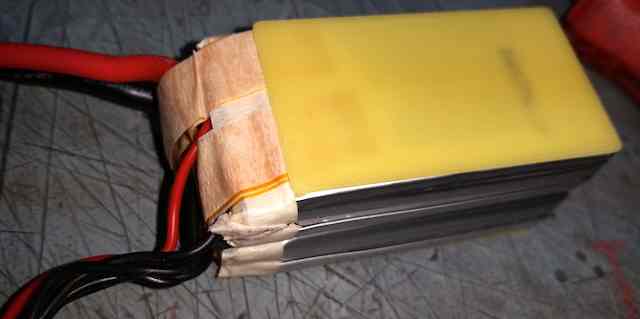
Photo by rampman on RC Groups Fiberglass (G10) plate on Hobby King Graphene LiPo Battery RC Devotee, "Dinogy have an advantage the others do not, a G10 plate on the top and bottom of the pack to offer protection in a crash. This is a new feature for these packs, and something not found in other packs in this class (some use aluminum, but aluminum dents/bends and is not a good form of protection.)
MCSGUY, "I think we will see more of the hard side plates. A major brand has recently started using G10 because it provides the benefits of aluminum (protecting the cells and remaining solid) but will not bend from crash impact." Protection might not be the biggest asset of plates. REVOJohn, "Did you know squashing the packs between two tight plates (as they use carbon fibre) does help in cycle life?" Listing of China original equipment manufacturer (OEM) for LiPo batteries Grepow
A note about GensAce, Tattu, Pulse and Glacier batteries by RC Devotee on RC Groups
I've heard from a fairly reliable source that Pulse is owned by family of the Grepow owners. I imagine they buy them assembled and just rebrand them. Glacier are also the same cells, but the company is not related in any way (blood or legally) as far as I know. Some say Pulse gets the best cells, others Tattu, and others Glacier. My money is on they are the same exact lots rebranded with no consideration to who gets the pick of the lot. The testing seems to show they all perform the same. There are sure to be others that buy from Grepow and rebrand. These are just the most known brands selling those cells." SaiRi as manufacturer AKA Shenzhen SaiRi Battery Co., Ltd.
LiPol Battery Co., Ltd.
Roaring Top LiPo may or may not be manufacturer's name
Shenzhen VigorPower
Revolectrix batteries are known as RevoBlends
A List of Brand Names and One Supplier Each for That Brand of LiPo Battery, February 2016
Admiral at Motion RC AtasSphere BLITZ HV at Drone Matters
Bonka at Multicopter Batteries
Cheetah at BP Hobbies DBY-Power at Heads Up Hobby
Dinogy at Dinogy LiPo USA Dymond at Dymond Modelsport USA E-flite at Horizon Hobby E-flite, Kinexsis, Predator, Venom Fly and Yuneec at Force RC ElectriFly at Tower Hobbies EZ Flight Pro at Heads Up Hobby FlightPower at Tower Hobbies GensAce at Gensace & Tattu online shop Genesis Power at Banana Hobby GFORCE at Value Hobby Giant Power at Mojo Racing Glacier at Buddy RC Hobby People at hobbypeople.net Hyperion at All E RC Lectron Pro at Common Sense RC Leopard-Power - Looks like does OEM for others, has some sort of relationship to SkyRC and MAY be the producer for Sky LiPos for HobbyPartz.com. Lumenier were at Get FPV.com, but they have Tattu brand now. Hard to find sources, but some are at FliteTest.com and ProgressiveRC.com. Mad Dog at 2DogRC Magnum Energy at Motion Unlimited MaxAmps at MaxAmps.com Multistar Race Spec at HobbyKing.com NeuEnergy at NeuMotors PowerWing at HobbyExpress.com Pulse at Ultra Pulse RevoBlends at Revolectrix Singapore Store Rhino at HobbyKing.com Roaring Top at Roaring Top USA RRC at Radical RC SkyLipo at hobbypartz.com SMC at Superior Matching Concepts Spyder are no longer carried at Progressive RC. Dave has GensAce and Tattu. Tattu at Gensace & Tattu online shop Thunder Power at Thunder Power RC Turnigy Bolt (UHV) at HobbyKing.com Turnigy E-flite & Parkzone series at HobbyKing.com Turnigy Heavy Duty - HobbyKing.com - I can't find a direct link to the HD line but their search will find them Turnigy Graphene at HobbyKing.com
Turnigy nano-tech A-SPEC G2 at HobbyKing.com Turnigy nano-tech at HobbyKing.com Turnigy LiPoly at HobbyKing.com VCANZ at Vcanz Power Venom at Venom Fly Xpower at Dualsky Zippy Compact at HobbyKing.com Zippy LiPoly at HobbyKing.com Part 2
What is/are your LiPo battery/batteries stored in right now?
What size battery pack, or how many Watt-Hours (Wh), is your LiPo 'bag' designed or rated for? What is YOUR plan in case of a charging, transportation or storage incident? How does the way YOU handle a LiPo battery influence the chance of an incident? A few brands of LiPo 'bags' note the pack size (cell count and capacity) or the Watt-hours (Wh), which is the energy capacity, that their brand of LiPo 'bag' is designed to contain in case of an 'incident'. Besides storing a LiPo battery, a 'bag' will most likely be used for containing a LiPo battery while charging, therefore, I use 4.2V per cell when calculating Watt-hours (Wh). It appears that suppliers use 3.7V for shipping purposes and as 'storage' voltage.
A Look At Some 'Bags' that give specifications Mark Woods' LipoSack (brandname)
LipoSack FREE REPLACEMENT GUARANTEE
LipoSack Survivors
Traxxas Charging Bag LiPo, size: 9" x 11.5" "Only for use with LiPo batteries rated up to 30 watt hours*", $21.83 Great Planes ElectriFly SafeCharge LiPo Charge Bag, size: 9" x 12.5" rated to 3S 3200mAh, converted to maximum Wh - 40.25, $21.99
And now the waters get murky!!!
Poor bag tested against a good one
A Blow Torch Test
Real LipoSack Test
Other Ways to Store and Transport LiPo Batteries "Fire Safes" and ammo cans have been used. Safe Home Storage, LiPo Bunkers A simple, effective bunker from the UtahFlyers.org
FliteTest LiPo Bunker
Another POSSIBLE, if it is not 'vaporware', 'Safe Charging' Option, the Bat-Safe - Battery Charging Box, February 15, 2016. It was fully funded on Kick Starter on March 07, 2016.
Another Means of Creating a LiPo Battery Fire For 'Bag' and Bunker Testing There is a problem with the Battery 'bag' and bunker testing videos. It appears, that for all of the bag and bunker tests, the LiPo battery was intentionally overcharged to get it to ignite. The increasing voltage in each cell was the cause of the ignition. When the cell voltages rose, the watt hours (Wh) and energy went up as well.
The Buddy RC LiPo Bag Test gives an indication of how much the watt hours of energy were increased to before the incident took place.
Forcing an over-charge demonstrates what might happen if the charger is 'set' incorrectly, or if the charger malfunctions (i.e. during charging), but the Buddy RC example illustrates the major 'flaw' in testing LiPo 'bags' ONLY by forcing an over-charge. Forcing the over-charge increases the energy available to the incident. Dead shorting the battery does not. Dead shorting yields results based only on the stored energy (i.e. in storage). Many videos, demonstrating shorted LiPo batteries, show no visible flames. In some of the videos of 'dead shorts', sometimes the wires burned/melted, or tabs burned off first, or there was just no ignition. LiPo Battery Short FAIL goes up in Smoke but Burns wires off
Lipo dead short test
old LiPo 3S 900mah short circuit
Sometimes it takes some 'intervention' before a fire will start. Shorting Out a 3s Lipo Battery = Fire...eventually
Sometimes shorted LiPo batteries will just ignite. lipo short circuit and fiery explosion.
LiPo short circuit 6 cell, 5000mAh
Demonstration of shorted LiPo in a Lipo Guard bag. LiPo Burn Test
Pack Handling The way the pack is handled can have a direct impact, pun intended, on the chances of an incident. LiPo pouch cell packs are not physically protected very well. Avoiding physical damage during storage, transport and use is important. A battery can be 'accidentally' set up to fail by pulling on the power lead or balance lead wires.
John Julian (jj604 on RC Groups) reported the following:
Rick (rampman on RC Groups) has disassembled and repaired over 1000 packs.
Regarding a pack he fixed, "I removed cell #1 from a 4S and made it a 3S. Reason? The "+" tab broke off at the cell. In this case it was NOT a short but being there was corrosion all over this area and this area only, it was most likely a leaking seal around that tab which weakened the metal tab via corrosion and it eventually snapped off under stress OR just in storage." "I have seen PCB failures (early large Turnigy packs), bad tab to tab soldering, failed spot welds, failed crimp connections (tab to tab on alum tabs (TP) where they somehow crimp the tabs together, I feel this is a very good process) cold solder connections, broken tabs for no seen reason..." 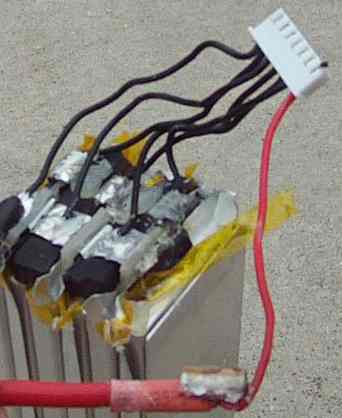
GensAce Failure Frank Siegert, in "Lithium Polymer Battery Technology: An Introduction" demonstrates what another likely cause of 'tab failures' is, besides poor quality control and craftsmanship. It has to do with the where the heat development happens.
 If the pouch tabs get hot enough, anything soldered can melt. Handle all packs with great care. Added 10/26/2016 MSGUY on Dinogy and Thunder Power Pack Construction
Thunder Power and Dinogy pack construction compared There are five photos on this page that compare the TP 2S 65C 6000mAh and Dinogy 4S 5000mAh pack construction.
The wider cell tabs, noted by MSGUY, are possible because the cell is designed so that the anode material protrudes from one end of the cell and the cathode material from the other. Wider tabs 'should' be able to handle larger currents. A problem arises when making odd cell packs with this type of cell construction. A wire must run from one end of the pack to the other, as in the photo below. Four 5S Dinogy packs are shown in a racing boat. The photo was originally at http://losi5iveforum.com/mobiquo/minisite/site/MainTopic.php?cmd=getThread&tid=4271, but the link is no longer viable. 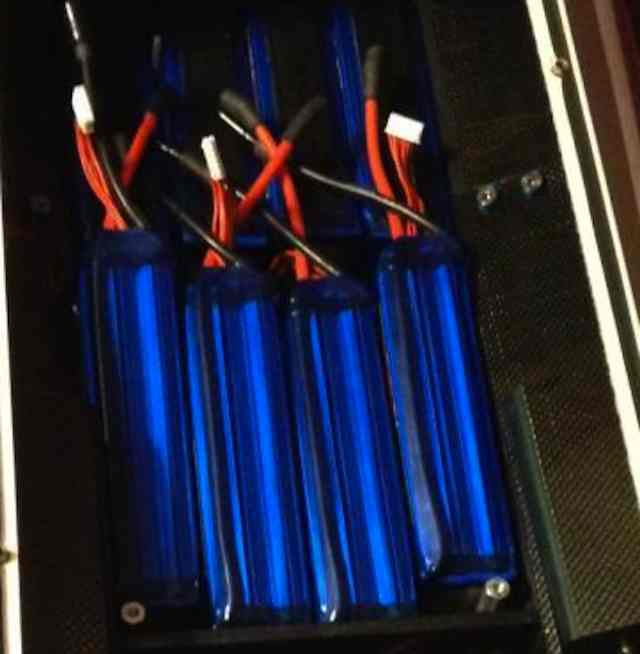
In this case they chose the positive. End of added section 10/26/2016 WARNING The following is purely anecdotal information from Ken Myers! For many years I have carried an old 1/2 credit card, cut lengthwise, in my flight box. This tool has been used to slide between the hook-and-loop fastener between the battery tray and battery to loosen a LiPo battery for removal without pulling on any wires. I had read about this method years ago. It works well, IF the tool will fit in the battery compartment. I recently acquired a plane that, because of space limitations in the battery compartment, does not allow the 1/2 credit card method to be used. Keeping in mind that any pressure on the outside of pack is 'bad' for it, I used a method to get the packs out without pulling on the wires, but unfortunately, it still puts pressure on the pack. Actually just using Velcro to secure a pack in a plane puts pressure on it when it is secured and 'pull' on it when the pack is removed.
Whether, in the long run, this pull method is going to damage the pack is totally unknown. I am not recommending it anyone, but I'm just sharing what I am using right now, when I can't use the 1/2 credit card method. Update: 02/08/2016: Richard Utkan, EFO vice-president, visited today with some questionable batteries for me to look at and test. I noted that he uses the same type of pull tab on his packs. He had a problem, long ago, that involved pulling the wires out of a pack. This was his solution as well. gocards, on RC Groups, did just about everything right when using and storing LiPo batteries. Unfortunately, he did not have a plan when the incident did happen while USING IT on his granite top bar in the kitchen.
I've been working with lipo in RC for a few years now. I am generally careful. I don't leave them charging unattended. I store them in lipo safe bags. I charge them in lipo safe bags. When charge is over I remove the lipo and bag it, etc. Never occurred to me to have it in a bag on the counter when using the battery. I have a brand new Lipo, 2200 mah, 4s. Flown it in a 250 quad maybe 2, 3 times max...turn on Tx, plug in quad, plug into PC...looking through settings, then "SSSSHHHHHSSSSHHHSSSSHHHH" sound and SMOKE like a smoke bomb! Oh and it STINKS! I was sitting at the bar in my kitchen, lipo was on granite top, entire family is asleep... Its smoking like a train! Front door is close, its cold and wet outside, gotta get this thing outside ASAP before it catches something on FIRE! I reacted...grabbed it (stupidly) and chucked it out the front door into the wet lawn where it smokes and flames up and its TOAST. ...nothing was damaged (aside from the battery). Just trying to get a game plan in my head in case this happens again. I am thinking to keep small fire extinguisher out and close by...also thinking of keeping some hot mits, like Ov-Glove or something close by in case I need to grab the thing. Moral of the story...it can happen to you. Be ready in case it does! Boldface type was used to identify the relevant statements. A thread on RC Groups asked, "Best environment to charge batteries?"
Plan ahead to be PROACTIVE instead of REACTIVE. Questions How many LiPo batteries should YOU store together? What happens to the outside of a LiPo 'bag' that is covered with a "plastic-like" cover or coating when there is an incident? What battery capacity is YOUR LiPo bag rated for? What is your home, personal property, vehicle and life worth to YOU? What is YOUR plan, in case of an incident, in YOUR home; YOUR Vehicle; or at the field? Are you actually going to use this information or not? Reported LiPo Fires and their probable causes
LiPo Fires Are Real
Part 3
Actual FACTS regarding almost all aspects of Lithium Polymer Pouch Batteries (LiPo Batteries) are difficult to come by. Where did all of this information come from? What is its genesis? One of the earliest documents, and possibly THE High Discharge Rate (HDR) LiPo Battery Genesis Document, is:
Historical Note: Thunder Power was started in 2003. They did not use HDR type cells. Their cells were rated at 3C and 4C with 5C bursts. p. 40, Kokam info. About 1980, Lithium Ion (Li Ion) cells began to be used for light duty, lightweight applications. Li Ion cells began to be modified for RC from retired cell phones and surplus sources only about two years ago. (That would be 2001 KM) Lithium Polymer (LiPo) cells began to see use in 2001 in a small way. The "small way" was primarily in the form of the Kokam Engineering Co., Ltd. 145 mAh cell. Mr. J. J. Hong, President of Kokam, provided the following brief history of the development of LiPo technology: Early in 1980, Motorola and Sony decided to apply lithium ion technology to the mobile phone... They developed a safety module, the so - called PCM (protection circuit module). Meanwhile, the Bellcore Lab in San Diego announced that they had developed the lithium polymer battery to increase energy density and safety by using a plastic pouch packaging/stacking method using an ion conductive separator named PVDF (polyvinyldifluoride) which has good binding characteristics at 1000 C. Sony, Toshiba, Panasonic, Samsung, Saft, Varta, Valence, Ultra-life, Polystar and perhaps 30 companies bought licenses to commercialize the Bellcore technology. No one was successful using that technology. Everybody gave up or went bankrupt. Kokam evaluated the Bellcore technology as an alternative, but realized that it is not a practical technology for commercialization due to the processing difficulty. Kokam decided to develop new technology with assistance from the Korean government agency named KIST (Korea Institute of Science and Technology). J. J. Hong invented a new system which permitted Kokam to make the battery easier without losing any performance over Li Ion and provided better safety. Kokam acquired patents all over the world and started to design the full process and equipment suitable for mass producing Kokam cells. German and Chinese companies licensed Kokam technologies. Kokam technology created the first 20C discharge rate commercial LiPo battery. All electric solar car champions used Kokam batteries in 2002 and 2003 competitions. Fred Marks continues:
LiPo technology advanced farther than NiCd technology advanced in nearly forty years. In 2002, the standard Kokam cell was capable of continuous operation at three to four times the multiple of capacity (3 to 4C) with 5C as the upper limit. In the past six months, Kokam introduced, and FMA markets, cells capable of sustaining up to 20C continuously with loss of but 12% capacity. (This is 2003. The 20C rating was NOT all of their HDR line, but only one cell. A bit misleading. KM) The use of LiPo cells in radio control applications is unique. All other applications require protective circuitry that prevents a) overvoltage during charging, b) discharge below 2.5V/cell and c) cell overloading. RC models can't tolerate complete loss of battery power (because the receiver and servos must be powered at all times during a flight), so protective circuitry is not an option. For this reason, the RC user bears special responsibility for the proper use of LiPo cells in radio control applications. This Application Note provides guidance for safe use of this new technology. IMPORTANT NOTE: While the precaution states that there is no use of a protection circuit module on RC LiPo cells, the document notes, p. 30, that Kokam developed a protective circuit, known as Safety Guard, for charging up to 4S packs and discharging up to 20 amps. FMA Introduced a Complete System to help modelers transition from high discharge NiCad and high discharge NiMH batteries. 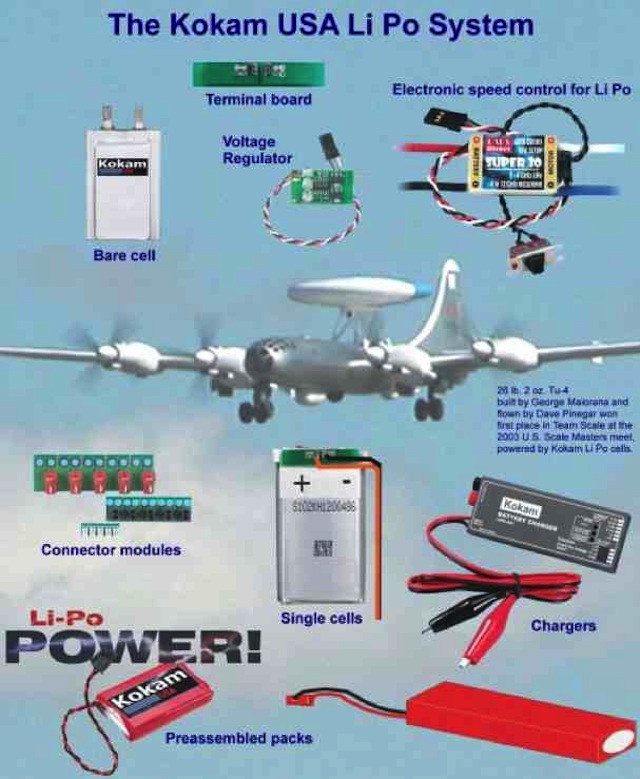 The document explains how each of the components of the system work together. Other significant mentions in the document "Kokam USA uses Deans Ultra connectors for larger packs." p. 18. "The preferred charge rate is 1C such that the cell can be charged to 90% capacity in one hour if the charger is designed to hold charge current at 1C without exceeding 4.235V/cell maximum charge voltage." p. 27.
Kokam HDR cells are compared to E TEC and Thunder Power non-HDR cells, p. 37 - 42. Why using a factor times the capacity is NOT a good way to 'rate' a LiPo battery, p. 38, "The rate can be presented as absolute rate in amps or as the rate as a multiple of the rated capacity. Note that the international standard for rating cells cautions against using XC to reflect discharge current since C = mAh, not mA. However, it is a convenient way to compare, even if not pure." No packs of the day had balance connectors, but the importance of balancing cells is mentioned and described on p. 43. Peak Burst Current Defined, p. 49, "*Peak burst current is a cycle consisting of less than 12 seconds of peak current followed by 50 seconds at 50-60% of peak current." A few of planes being flown with Kokam cells in 2003. 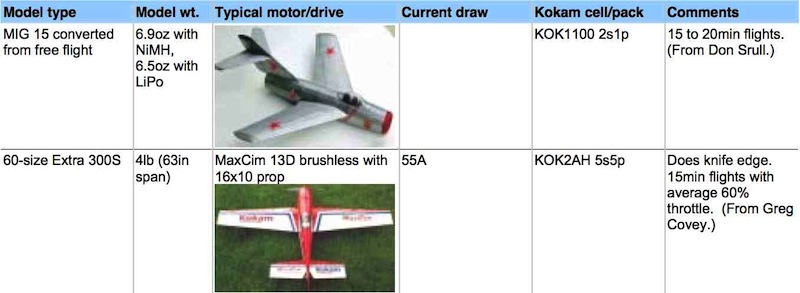
Much other documentation, found elsewhere through the years, is based primarily on this pioneer work. Continuing from the document Safety p. 25
1 An overvoltage protection circuit which rapidly places a low resistance shunt across the power supply output terminals if a predetermined voltage is exceeded.
Again Note, this is a, if not THE, genesis document. Some of the information has been borrowed and modified over time and some of the information has been 'dropped' altogether, by FMA Direct and others supplying LiPo batteries. WARNING Safety Precautions for Lithium Polymer and NiCad cells/packs stocked by FMA Direct p. 26
"...If a cell is found to be swelling during charge, remove the charge current immediately. Then allow the cell to cool before taking any other action. You can imagine that rupture of the cell could allow hot gasses and electrolyte to spew out.
LiPo Battery disposal instructions/directions illustrate the problem of obtaining factual information.
Questions Have YOU disposed of any LiPo batteries? If so, what procedure did you use? Were any disposal instructions provided with your LiPo battery? Did you follow them? Have YOU ever read the disposal directions supplied with your LiPo batteries, if there were any instructions? Does YOUR LiPo supplier have disposal instructions on their Web site? Have YOU ever looked up LiPo disposal on the Internet? What did YOU find? Have YOU ever seen conflicting LiPo disposal directions? HobbyKing instruction sheet/manual
GensAce/Tattu - pack insert instruction sheet/manual
Great Planes - pack insert instruction sheet/manual
1. Place the LiPo battery in a fireproof container or bucket of sand.
Model Aviation magazine 2015
Jay Smith and Rachelle Haughn, "LiPo Battery Basics: Storing and disposing of your batteries", October 2015, p. 61 - p. 62
Roaring Top LiPos
Common Sense RC
1)Discharge the battery to 0 volts.
Thunder Power
Horizon Hobby
Revolectrix
1. ask your local battery retailer if they will take your old batteries and recycle them
MaxAmps.com
FMA LiPo Handbook Section 3
FliteTest Web site
How to Discharge and Dispose of LiPo Batteries T JinTech How-To: Safe lipo preparation for disposal
Inexpensive Lipo Discharger That Works!
The Genesis Document Information Update of 2005 The follow-up to the FMA Direct 'genesis' document
Introduction
Significant mentions
FMA LiPo Handbook Section 2
Significant mentions
FMA LiPo Handbook Section 3
Significant mentions Lithium metal oxide is the base material (cathode) and Carbon is the anode in Kokam cells p. 5
Use of aluminum soldering paste that deteriorates the tabs and causes a short circuit. p. 3 Charging in series and parallel are described. p. 12 Photo of ammo can in text p. 13 "By international standard, all cells are rated for capacity at 0.2C, where C = nominal capacity of the cell when discharged at a rate equal to 0.2 times the predicted capacity for the cell. The rated cell capacity is actually statistically established since the actual is not known until tested." p. 18 "That is about 80% of capacity and time to stop flying if you wish to maximize cycle life...", p. 19. LiPo Battery Facts or Fancy? Understanding whether LiPo Battery facts are truly facts, recommendations or opinions is extremely difficult.
An Example: LiPo Operational Temperature Ranges It is important to remember that the following temperatures are the operational temperatures of the cells/packs and NOT the ambient temperature. In 2003 The Kokam USA Lithium Polymer Battery System document had only one note about temperature.
But by 2005 the FMA LiPo Handbook Section 3 - Safety
RevoBlends
Roaring Top
LiPol Battery .COM
ThunderPower
Hobby King manual/instruction sheet packed with packing slip in box
All of the statements regarding the operating temperature range of LiPo batteries are stated as facts by the various sources.
The procedure I use to determine the validity of a fact or 'recommendation'? How does fact or 'recommendation' compare to information in Frank Siegert's previously recommended "Lithium Polymer Battery Technology: An Introduction".
Temperature Related Failures If the temperature is too high, greater than 600C (1500F) (greater than 550C (1310F) with newer type cells) the Cathode releases oxygen and the Anode has a SEI layer breakdown. If the cell temperature is too low, less than 15-200C (59-680F) at a high C-rate, the Cathode is stressed from too high of a lithium-ion flow and breakage and cracks occur during discharge.
Frank does not note an actual minimum charge temperature. Next: Is there reference to the factor or 'recommendation' in the genesis document? In this case there is not. Is there a reference in the 2005 FMA LiPo Handbook Section 3 document? Yes, noted previously. Is there a reference to the fact or 'recommendation' on the RevoBlends site?
The Roaring Top and LiPol Battery info 'coordinates' with the FMA info and may, or may not, be taken from the same source. The question is: Is it the same info given three times, or separate instances? The Thunder Power and Hobby King recommendations are reasonably close to the same temperature range. MY conclusion is that the temperature ranges given by all the references are valid. A Guide to Understanding Battery Specifications
Roaring Top
Steps in checking out a site for validity
A Homework Assignment
The questions YOU should know the answer to, or be able to find, now.
Only YOU can determine the trustworthiness of your source(s). The following is a list that I have found to provide accurate information. John Julian, Melbourne, Australia RC Groups: jj604
Mark Forsyth, So. California, RC Groups: mrforsyth
Wayne Giles, Rugby, UK, RC Groups: Wayne Giles
Joe Giamona, State of Washington RC Groups: MCSGUY
All about lipos for RC models from Bruce Simpson at RC Model Reviews
Race Miata (RC Groups) of Vancouver, CA
Rick Gilbert, AZ RC Groups: rampman
At the other end of the Spectrum! The following represents what I believe to be very bad information, and I would not view this person as a trusted source. Really Bad Recommendations by Danal Estes
| |||||||||||
